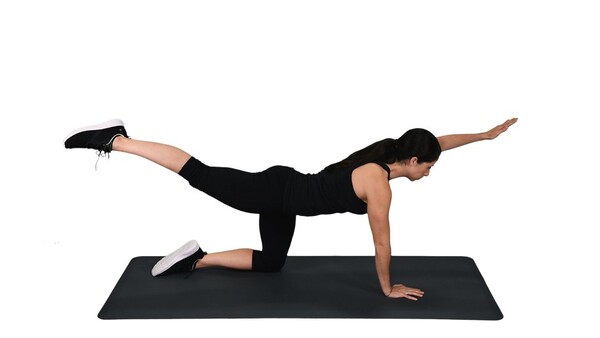You can use things like dumbbells, kettlebells, medicine balls, and cable machines to train your abs but, sometimes, simple is best. Ab In and Outs are great exercises for working your stomach muscles hard! Read this article to find out how to perform in and outs exercises.
What Is The In And Out Abs Exercise
The in and out is a type of abdominal exercise that works the quadriceps, hip flexors, and abs. There are several ways to progress or regress this exercise, which is primarily used to isolate the abs.
The traditional in and out abs exercise is difficult and tests your entire body’s stability and coordination in addition to your muscles. It might take some time and effort to develop the necessary core strength for the full in and out position.
This movement and full-body engagement, when performed properly, will be beneficial to the entire body. This movement has the great benefit of being very accessible since it doesn’t require any special equipment and can be performed anywhere.
How Muscles Work When Doing In And Outs Workout
Although in-and-outs are typically thought of as an exercise for the abs, several other muscles are also used in this movement:
Rectus abdominis – the rectus abdominis is the large, flat muscle on the front of your abdomen. The majority of people perform in-and-outs with this as their agonist or prime mover. Your spine’s flexion is the primary function of the rectus abdominus.
The linea alba, a ligamentous tissue, divides the rectus abdominus into segments, giving it a recognizable six-pack shape. This is only apparent, though, if you are extremely lean.
Transverse abdominis – where the rectus abdominis runs vertically up the front of your abdomen, the transverse abdominis runs horizontally. By contracting inward and creating intra-abdominal pressure, or IAP for short, it aids in stabilizing your spine.
Obliques – the obliques are basically your waist muscles. Your spine’s lateral flexion and rotation are their primary functions. They primarily serve as stabilizers during in and outs to stop unintentional movement. Some variations, though, specifically work your obliques.
Iliacus and psoas major – collectively known as the iliopsoas, these muscles flex your hips. The Iliacus and psoas major, which are not abdominal muscles, are very active during in and outs.
Rectus femoris – the rectus femoris is one of your quadriceps muscles. It assists the Iliacus and psoas, major, in flexing your hips during in-and-out motions.
Benefits Of Ab In And Outs
Strengthen Core
A strong core is essential for good balance, posture, and stability and offers a wealth of advantages for everyday functional movements.
Popular Bodyweight Exercise
In and Out abs, which use only your body weight, are a well-liked form of exercise for anyone looking to strengthen their core while at home or even on vacation without having to find a gym or buy special equipment.
Abs Of Steel
Anyone looking to improve the definition of the stomach muscles and develop or maintain the “six-pack” look should consider in and out abs because of the core abdominal strength required.
Hip Flexibility
This exercise puts a lot of strain on the hip flexors, which are essential for a variety of everyday movements (including walking, kicking, bending, and pretty much all lower body motions). You can perform these movements more easily and safely if your hips have increased strength and flexibility.
Drawbacks Of Ab In And Outs
While in and outs are generally advantageous, there are some cons to take into account as well:
Lower back strain – the Your spine can become overextended due to the attachment of the iliacus and psoas muscles to your lumbar vertebrae.
However, if you have weak deep core muscles or hyperlordosis (an abnormally large lower back arch), in and outs could put a lot of stress on your lower back, resulting in back pain or injury. A strong transverse abdominis should prevent this from happening.
Limited overload – initially, lifting your legs should provide the target muscles with an effective workout but, as you get stronger, you may find that the only way to challenge your abs is to do more and more reps. High rep abdominal exercises are not very time-effective and won’t help your abdominal muscles get much stronger.

How To Do In And Out Abs Exercise
To do ab In and Outs:
- Beginning in a seated position with your legs bent and flat on the floor in front of you, your arms on either side of your body.
- As you lift your hands, feet, and knees to your chest, tighten your abdominal muscles and maintain a straight back. You are now in the ‘in’ position
- Legs straightened in front of you, gently lean back while maintaining a straight spine. Imagine the movement as a balancing act between your upper body and legs, with your bottom being the only part of your body that makes contact with the floor
- Hold the position as your shoulders approach the floor, avoiding letting them or any other part of your body except your bottom make contact with the floor. You are currently in the “out” position.
- As you do so, raise your shoulders and bring your legs back to the “in” position. Keep your abdominal muscles tight throughout.
- The desired number of repetitions should be performed with the “in,” “out” movement.
Stop the exercise if you experience any discomfort or are unable to maintain a tight core so that the movement is controlled. To better get your core ready for this more difficult movement, you might want to think about trying some of the simpler variations listed below.
A demonstration of the exercise is shown in the video down below. Try adjusting the speed to really feel the burn and put your core stability to the test. Ensure your stabilizing muscles are activated and put to the test by performing a few extremely slow reps followed by some faster ones.
Common Mistakes When Doing The In And Out Abs Exercise
The in and out exercise’s most frequent errors involve launching into an advanced variation of the movement. If you see any of the following errors, use a regressed in and out version:
- Excessively rounding through the back: Always maintain a neutral spine (straight spine) throughout the exercise. As you move away from each landmark, visualize lengthening from your head’s crown all the way to your toes. To ease the strain on your neck, retract your chin.
- Reaching all the way to the ground: Be careful to avoid letting your shoulder blades, midback, or legs touch the ground when you are in the bottom position of the “out” position. Your core won’t be activated when you reach all the way to the ground, which can put a strain on your lower back.
- Holding your breath: It is very simple to overlook proper breathing mechanics when working on your core muscles. Yes, breathing is difficult, but it will feel much more in tune once you get used to it. Take a deep breath in as you expand into the “out” position, and then forcefully exhale as you contract and come to the center of the “in” position.
- Losing balance: Your balance will be maintained during the in and out exercise with the help of full body tension. When activating your entire body, you should keep your legs close together, engage your lower body, brace your entire midsection, and actively reach your arms forward.
In And Out Ab Variations
Floor Surface
Perhaps a no-brainer, but using a yoga mat or cushion is likely to be helpful if you find it uncomfortable to support your weight on your bottom. Our most recent guide on Pilates head cushions has some multipurpose cushions that would be useful in these circumstances.
Master Gentler Abdominal Workouts First
Keep in mind that this is an advanced core exercise, so it is crucial that your abs are strong before you begin. Work on less demanding substitutes like regular sit-ups, T-raises, or ab crunches to prepare for this exercise.
Another excellent exercise for developing that essential core strength is ab pulse-ups.
Repetitions
Like with any exercise, increasing the number of repetitions makes the workout harder, as long as you don’t lose the proper form in the process. It is generally accepted that burning fat can benefit from doing more repetitions.
Slow The Pace
You can advance the exercise by slowing down the movement in addition to increasing the number of repetitions. This makes your muscles work harder and under tension for a longer period of time, which can hasten the development of your abdominal strength.
To make the abs work harder, you can also pause between each “in” and “out.”
